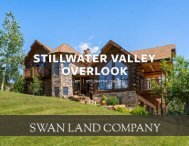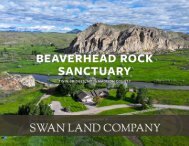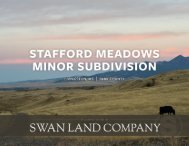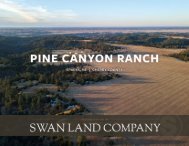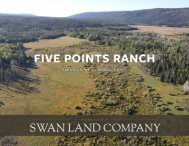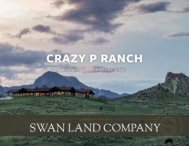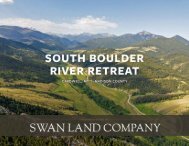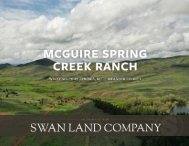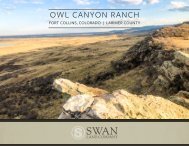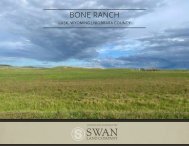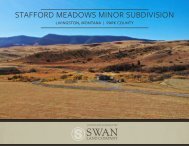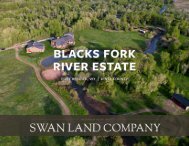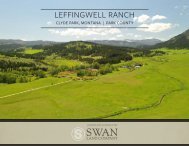You also want an ePaper? Increase the reach of your titles
YUMPU automatically turns print PDFs into web optimized ePapers that Google loves.
<strong>LF</strong> RANCH<br />
AUGUSTA, MONTANA | LEWIS & CLARK COUNTY<br />
LISTED EXCLUSIVELY BY
TABLE OF CONTENTS<br />
INTRODUCTION1<br />
THE CROWN OF THE CONTINENT 2<br />
LOCATION & ACCESS3-4<br />
RANCH FISHING & HUNTING5-9<br />
AREA RECREATION 10<br />
ACREAGE11<br />
CATTLE OPERATION 13-14<br />
IMPROVEMENTS 15-17<br />
UTILITIES & SERVICES 18<br />
REAL ESTATE TAXES 18<br />
FENCES & BOUNDARY LINES 18<br />
WATER RIGHTS 19<br />
MINERAL RIGHTS 19<br />
ELEVATION & CLIMATE 20<br />
RANCH HISTORY 21<br />
AREA HISTORY22<br />
SUMMARY STATEMENT24<br />
OFFERING PRICE & CONDITIONS OF SALE 25<br />
CONTACT INFORMATION26<br />
AREA & RANCH MAPS 27
INTRODUCTION<br />
“Complementing the big-fish experience are the awesome scenery and the sense of timeless<br />
remoteness; there is no place quite like this. Close your eyes and think of Montana 150 years ago.”<br />
Charles F. Gauvin, President and CEO Emeritus, Trout Unlimited<br />
— 1 —<br />
The historic <strong>LF</strong> <strong>Ranch</strong> is, simply put, one of the most magnificent<br />
Montana ranches to become available in decades. The <strong>Ranch</strong><br />
encompasses almost 42,215 deeded and leased acres, a sizable<br />
property even by Montana standards. But it is the astounding<br />
diversity of this wild and pristine acreage – almost all of which is<br />
enclosed within ranch boundaries that makes the <strong>LF</strong> so spectacular<br />
and unique. The <strong>Ranch</strong> rises from lush prairie grasses through<br />
riparian zones along its many creeks, past the iconic Haystack<br />
Butte, and up the Rocky Mountain Front to the Lewis and Clark<br />
National Forest, with which it shares a boundary for almost eight<br />
miles. The Rocky Mountain Front wraps around the <strong>Ranch</strong> on<br />
the south and west, forming what is, in effect, a privately-owned<br />
preserve with all the attributes of a national park.<br />
This is the heart of the Crown of the Continent, one of only two<br />
intact ecosystems remaining in the lower 48 states, and home to<br />
possibly the richest collection of wildlife in North America. The<br />
<strong>LF</strong> <strong>Ranch</strong> is a jewel in that crown.<br />
Five spring-fed streams, offering over 37 miles of trophy trout<br />
fisheries, and over 113 miles of riparian habitat serpentine<br />
through the <strong>Ranch</strong> creating private fisheries that yield large, healthy populations of rainbow and brown trout. Virtually every mammal known to the<br />
American Rockies – elk, mule deer, white tail deer, antelope, moose, bighorn sheep, grizzly bear, wolves, mountain lion – lives here, as well as grouse<br />
and Hungarian partridge. The plethora of wildlife coupled with the diverse terrain, running waters and the protected boundaries makes for unmatched<br />
outdoor experiences, whether fishing, hunting, hiking or horseback riding.<br />
The <strong>Ranch</strong> currently runs about 1,300 head of cattle and produces about 700 tons of hay annually. This is a low-overhead operation that, under present<br />
ownership, has consistently operated in the black. Facilities, including barns, chutes, docks and pens, are well maintained and efficient. The residential<br />
improvements, including a charming owner’s cabin, are modest but comfortable and designed for recreational use and utilitarian staff housing.<br />
The <strong>LF</strong> has had only two owners since famed Montana rancher J.B. Long first assembled the property in the early 1900s. Over the last 30 years, the<br />
current owners have enhanced the holding with strategic acquisitions and careful stewardship of the land and native habitat. The result is a legacy ranch<br />
of unsurpassed beauty and biodiversity that also presents an attractive land and conservation investment.
THE CROWN OF THE CONTINENT<br />
The Crown – aptly named for its majestic geology – forms the spine of the Rocky Mountain Front and the eastern edge of the Continental Divide. It<br />
extends from the northern Canadian Rockies in British Columbia and Alberta southward into Montana through Glacier National Park to Rogers Pass.<br />
Rugged limestone peaks, sheer walls, protrusive reefs and deeply cut canyons provide a view scape like nothing else in North America. Some of the<br />
nation’s most important protected wilderness areas are here: The Crown is 10 million acres including the Lewis and Clark National Forest, which<br />
spans 2,912 square miles; the Bob Marshall Wilderness Complex, the fifth largest wilderness area in the lower 48 states at over 1 million acres; and the<br />
Scapegoat and Great Bear Wilderness Areas are more than a half-million acres within the national forest – all adjoining the <strong>LF</strong>.<br />
Here, in the wildest part of Montana's Rocky Mountains, are the headwaters of many major North American rivers and the origins of the Pacific and<br />
Atlantic Oceans and Hudson Bay.<br />
This special corner of Montana has a tangible, yet undefinable quality of<br />
life and land; much of it remains the way that Lewis and Clark experienced<br />
it over 200 years ago.<br />
“I’ve been fortunate to fish, hunt, and photograph all over<br />
the world. To this day, the <strong>LF</strong> <strong>Ranch</strong> remains one of the<br />
most enclosed, impressive, and untouched ecosystems I’ve<br />
seen. Big fish in small water, paired with endless views of<br />
undeveloped land is hard to find in any part of the world.”<br />
Nick Kelley, Photographer, Outside Magazine<br />
The <strong>LF</strong> is one with the Crown and possesses its own special geological<br />
features. Haystack Butte, an ancient volcanic plug, stands sentinel in<br />
the midst of the <strong>LF</strong>. At 6,800 feet above sea level, the peak is an iconic<br />
regional landmark, first remarked upon by Meriwether Lewis.<br />
The topography of the <strong>LF</strong> ranges from the rugged peaks along the western<br />
and southern boundaries that transition to mountain valleys, grassy benches to productive riparian bottoms. The backdrop of The Front to the west is<br />
captivating with snow-capped peaks and timbered hill sides to the rolling hills and pastures that contain healthy stands of native grass species.<br />
The Lewis & Clark National Forest, which borders the <strong>Ranch</strong> on the south and west for approximately eight miles, protects it from encroachment<br />
and shares the same marvelous biodiversity of the region. The Nilan Reservoir borders the <strong>Ranch</strong> on the northeast corner, with a finger of the lake<br />
extending into the <strong>Ranch</strong>. Five significant spring-influenced creeks – Ford, Smith, Goss, Blubber and Elk – flow from west to east through the various<br />
drainages within the <strong>Ranch</strong>.<br />
“The Front’s rich mosaic of glaciated wetlands, riparian corridors, mixed-grass prairie and coniferous<br />
forests is formed by the dramatic collision between mountain and prairie ecosystems.”<br />
The Nature Conservancy Annual Report 2015<br />
— 2 —
LOCATION & ACCESS<br />
The Headquarters of <strong>LF</strong> <strong>Ranch</strong> is located off Smith Creek Road, 12 miles west of Augusta. This quaint western town, population 315, boasts restaurants,<br />
a gas station, grocery store, post office and local watering holes, including the popular Buckhorn Bar for great dining, refreshments and local color, or<br />
stop for an espresso drink at Latigo and Lace.<br />
The Augusta public school system serves the surrounding area and features small, multi-grade classrooms. Augusta High School, a Montana High<br />
School Association Class C school (fewer than 160 students), offers competitive interscholastic athletic programs. School bus service provides roundtrip<br />
transportation for elementary and high school students in the area. The Augusta community has been supportive of the school system and has<br />
historically supported school bonds for capital improvements and upgrades.<br />
Choteau, the Teton County seat, is about 20 minutes north of Augusta and provides a range of services including banking, health care and a jet capable<br />
runway.<br />
— 3 —
LOCATION & ACCESS<br />
GREAT FALLS<br />
The <strong>Ranch</strong> is about 69 miles – or just over an hour’s drive – from Great Falls, the third largest city in Montana. Known as the “Electric City” for its<br />
hydroelectric dams, Great Falls is the commercial and banking hub of north central Montana. With a population of approximately 60,000, Great Falls<br />
offers a complete and diverse array of retail, dining and supply and equipment services. Great Falls Clinic Medical Center and Benifis Health System<br />
both provide quality health care and surgical services.<br />
UNIVERSITY OF PROVIDENCE<br />
Founded in 1932, the University of Providence, formerly University of Great Falls, is a private, Roman Catholic liberal-arts university located in<br />
Great Falls on 44 pristine acres. UP, which serves approximately 1,117 undergraduate and graduate students, offers about 60 certificate, associate,<br />
undergraduate and graduate programs in traditional liberal arts and sciences and in healthcare fields. In addition to its campus offerings, UP serves 31<br />
sites in Montana, Southern Alberta and Wyoming through its Telecom Distance Learning Program.<br />
For those interested in athletics, the University of Providence ‒ nickname: the Argonauts ‒ participates in a variety of men’s and women’s sports in<br />
National Association of Intercollegiate Athletics (NAIA) Region I and is a respected member of the Frontier and Cascade Conferences.<br />
AIRPORTS<br />
The Great Falls International Airport serves Alaska, Allegiant Air, Delta and United Airlines. Currently, direct flights are available to Denver, Las<br />
Vegas, Minneapolis, Phoenix, Salt Lake City and Seattle. For up-to-date flight schedules and airport information, please refer to the airport website:<br />
www.gtfairport.com.<br />
There is a well-maintained paved public airstrip situated on the northeast edge of Choteau, 38 miles from the <strong>Ranch</strong>. Located at an elevation of 3,942',<br />
the 75' x 5,000' asphalt runway is in good condition. Communications for this facility are available through Salt Lake City at Frequency 133.4/285.4<br />
(Great Falls RCAG).<br />
Augusta Airport (3U5) has a 3,650' x 75' turf runway at 4,145' elevation that is in fair condition. For additional information, contact manager Tim<br />
Connley at 406-444-2506.<br />
The <strong>Ranch</strong> also has a grass airstrip that is maintained and suited for single-engine aircraft, such as a Cessna 182 or 206. The strip could easily be<br />
extended for larger aircraft.<br />
Approximate distances to area cities and towns from the <strong>LF</strong> Headquarters are as follows:<br />
Augusta....................................................................12 miles<br />
Choteau...................................................................38 miles<br />
Great Falls................................................................69 miles<br />
Helena......................................................................88 miles<br />
Missoula.................................................................145 miles<br />
Bozeman................................................................183 miles<br />
— 4 —
RANCH FISHING & HUNTING<br />
“While I’ve had the good fortune of hunting and fishing a lot of properties in the Rocky Mountain West, I<br />
can say the privilege of pursuing upland birds and casting to trout on the <strong>LF</strong> <strong>Ranch</strong> is singular.”<br />
Whitney Tilt, Director, Land and Wildlife Conservation, The Arthur M. Blank Family Foundation<br />
The big game hunting, wing shooting and trout fishing on the <strong>LF</strong> are truly world class and have been enjoyed for decades by a select and notable group<br />
of sportsmen, including leading environmentalists, conservationists and chief executives of sporting companies. The private small stream and spring<br />
creek fishing on the <strong>LF</strong> is simply astounding. It is not an overstatement to say that the <strong>LF</strong> is the finest fishing ranch to hit the Rocky Mountain market<br />
in a generation.<br />
“I have been fortunate to guide anglers all across the world in the world’s best fisheries, and there is<br />
no place I would rather fish for trout in Montana than the <strong>LF</strong>. It offers New Zealand, Argentina and<br />
Montana on one piece of property.”<br />
Dan Vermillion, Owner, Sweetwater Travel Company, Livingston, Montana<br />
— 5 —
RANCH FISHING & HUNTING<br />
The <strong>LF</strong> is laced with springs, creeks, seeps, still ponds and lakes. The largest of the fishing creeks – Ford, Smith, Goss, Blubber and Elk Creeks – flow<br />
through the <strong>Ranch</strong> for approximately 37 stream miles.<br />
Ford Creek<br />
Smith Creek<br />
Elk Creek<br />
Goss Creek<br />
Blubber Creek<br />
— 6 —<br />
10.6 miles<br />
11.8 miles<br />
3.0 miles<br />
9.4 miles<br />
2.7 miles
RANCH FISHING & HUNTING<br />
“With its 30+ miles of private spring creeks, the <strong>LF</strong> is truly a unique fishing experience…I fished the <strong>LF</strong><br />
during hopper season and was amazed at the brown trout. Complementing the big-fish experience are the<br />
awesome scenery and sense of timeless remoteness. There is no place quite like this.”<br />
Charles F. Gauvin, President and CEO Emeritus, Trout Unlimited<br />
All of these fisheries hold remarkable numbers of trout, including some very large brown trout that regularly exceed 20 inches; several ponds, including<br />
the sizeable Smith Pond, offer exceptional still water fishing. The creeks rise from springs on the <strong>Ranch</strong> and from the adjoining wilderness areas and<br />
flow through the heart of the <strong>Ranch</strong>, thus creating a private fishing reserve that is unrivaled. It has often been said that an angler never steps in the same<br />
water twice and the diversity of the riffles, pools and grassy banks with deep corners that course through the <strong>Ranch</strong> will challenge and captivate anglers<br />
for a week, a season and a lifetime.<br />
— 7 —
RANCH FISHING & HUNTING<br />
“For the lucky few that have stalked their banks, the <strong>LF</strong> waterways offer an intricate labyrinth of<br />
adventure. Coupled with a well-placed cast – every bend, riffle and rock hold the promise of connecting<br />
with a large wild trout. The pure variability of angling opportunities is astounding.”<br />
Should the day come that an angler wants to venture off the<br />
<strong>Ranch</strong>, the famed nearby waters of the Dearborn, Sun and<br />
Missouri Rivers are all within an easy hour drive. Many<br />
consider the stretch of the Missouri River from Holter Dam<br />
near Wolf Creek downstream to Cascade the finest river in the<br />
State. The Sun and Dearborn Rivers originate in the renowned<br />
Bob Marshall Wilderness and offer less traveled fishing<br />
experiences. Local reservoirs including Nilan, which borders<br />
the northeast corner of the <strong>Ranch</strong>, Pishkun and Willow Creek<br />
offer additional still-water angling opportunities and in the heat<br />
of the summer are popular local boating destinations.<br />
As the summer fishing season transitions into fall, and sporting<br />
pursuits turn to the field, the big-game and wing-shooting<br />
opportunities on the <strong>LF</strong> are simply spectacular. The <strong>LF</strong> is home<br />
to moose, elk, bighorn sheep, mule and white-tailed deer and<br />
antelope. In September and October, the spectacular bugling<br />
and rutting displays of mature bull elk that occur throughout the<br />
<strong>LF</strong> etch permanent memories. Trophy record-book bulls are<br />
taken annually during archery and rifle season. With historical<br />
knowledge and many days in the field, ranch managers have<br />
defined nine distinct elk hunting zones that provide exceptional,<br />
unique and incredibly private experiences. The <strong>Ranch</strong> is located<br />
in hunting District 442, which is a general ‘over the counter’<br />
tag for elk and deer. With the burgeoning elk population in<br />
the area, the hunting season is generous and extends from<br />
September through February. For details on purchasing nonresident<br />
tags, specific regulations and additional information<br />
please refer to the Montana Fish, Wildlife and Parks website at<br />
www.fwp.mt.gov.<br />
Connor Flanigan, Fly Fishing Community Manager, Simms Fly Fishing<br />
— 8 —
RANCH FISHING & HUNTING<br />
“The <strong>LF</strong> is among the most amazing hunting properties in America.”<br />
Grayson Shaffer, Editor at Large, Outside Magazine<br />
Significant populations of Hungarian partridge and sharp-tailed grouse are observed throughout the <strong>Ranch</strong>. The seasonal grain fields through the core<br />
of the <strong>Ranch</strong> provide a readily accessible food source, which combines with an extensive riparian habitat along the creeks to greatly enhance the quality<br />
and numbers of wildlife. This habitat is apparent through the abundant numbers of elk, whitetail, mule deer and antelope scattered throughout.<br />
“I’ve enjoyed outstanding hopper fishing for big browns; I’ve followed pointers riveted to the scent of 30+<br />
sharptails. I’ve done nothing for timeless spells mesmerized by the back drop of the Rocky Mountain Front.<br />
I’ve watched 80 elk grazing high on Haystack. These are the daily treats that the <strong>LF</strong> doles out to its guests.”<br />
Perk Perkins, CEO, The Orvis Company<br />
— 9 —
AREA RECREATION<br />
North Central Montana offers endless opportunities for outdoor recreation from hunting, fishing, hiking and camping to golfing in the shadow<br />
of the Rocky Mountains.<br />
BOB MARSHALL WILDERNESS COMPLEX<br />
Located just west of the <strong>Ranch</strong>, “the Bob,” with 1.5 million acres, is the fifth largest<br />
wilderness area in the United States. Protected by the Wilderness Act of 1964,<br />
which prevents the construction of roads or structures and prohibits motorized<br />
vehicles and mechanical equipment, the Bob Marshall Wilderness area is accessible<br />
by foot or horseback via an extensive trail system. Hunting, fishing and camping<br />
are allowed with the proper permits. Grizzly and black bears, moose, elk, mountain<br />
goat, bighorn sheep, wolverine, wildcats, and lynx live here. Its vast, pristine beauty<br />
and magnificent wildlife make the Bob Marshall a bucket-list trip for outdoor<br />
enthusiasts worldwide.<br />
FREEZEOUT LAKE<br />
Northeast of the <strong>Ranch</strong>, near the town of Fairfield, lies Freezeout Lake. While this<br />
Wildlife Management Area offers hunting, wildlife viewing and iceboating in winter,<br />
it is also the primary staging area for snow geese in their spring migration from the<br />
Gulf States. In early March as many as 300,000 snow geese and 10,000 tundra<br />
swans gather at the lake to rest before continuing to the extreme northwest Arctic<br />
Coast of Canada. The <strong>LF</strong> lies along and under this major flyway and the sounds of<br />
thousands of migrating birds are heard for days each fall and spring from overhead.<br />
GO<strong>LF</strong><br />
The Harvest Hills Golf Course in Fairfield, features a “challenging but friendly”<br />
9-hole public course against the beautiful backdrop of the Rocky Mountain Front.<br />
Golfing is available at the public Choteau Country Club, as well as a new course at<br />
the Eagle Falls Golf Club in Great Falls.<br />
MISSOURI RIVER<br />
For many decades, travelers have journeyed down the Missouri River to see the<br />
inspirational rock formations and limestone cliffs. Scenic boat tours are available to<br />
enjoy the beauty that has not changed since the days of Lewis and Clark. To gain<br />
additional knowledge of the “Corps of Discovery” Expedition and the history of the<br />
area, it is well worth visiting the Lewis and Clark Interpretive Center in Great Falls,<br />
which offers lecture series, films and exhibits.<br />
— 10 —
ACREAGE<br />
<strong>LF</strong> <strong>Ranch</strong> encompasses approximately 42,215 total acres, including:<br />
• 22,220± Deeded Acres<br />
• 10,700± United States Forest Service Grazing Allotments<br />
• 9,315± State of Montana Leased Acres<br />
Based on <strong>Ranch</strong> tax records the deeded land includes:<br />
• 18,133± Acres of Agriculture (Range, Pasture and Crop)<br />
• 581± Acres of Flood Irrigated Hay Ground<br />
• 3,486± Acres of Forest<br />
• 22,220± Total Estimated Deeded Acres<br />
The leased land includes:<br />
United States Forest Service<br />
• 10,700± Acres Mountain Pasture (403 AUMs)<br />
• 2017 Cost: $570<br />
State of Montana Lease Land<br />
• 9,315± Acres of Native Range and Pasture (2,986 AUMs)<br />
• 2017 Cost: $37,855<br />
— 11 —
— 12 —
CATTLE OPERATION<br />
This low-overhead cattle operation runs with only two full-time men during the entire year. There is minimal farming and irrigation. The cattle are hardy<br />
and primarily calve on their own. The operation currently calves in early April, primarily to minimize stress on cattle, lower labor costs, and reduce the<br />
amount of hay fed annually. The <strong>Ranch</strong> utilizes three major pasture grazing programs — a calving block, a summer pasture and winter pasture — with<br />
the goal of reserving a third of the <strong>Ranch</strong> untouched going into the winter months. On a typical year, the <strong>Ranch</strong> feeds about a quarter ton of hay per<br />
cow. With rotational grazing of the spring and summer pastures, the <strong>Ranch</strong> is able to take advantage of native grasses at different times of the year and<br />
maximize forage production and usage. The abundance of spring and summer pastures, furthermore, facilitates rotationally grazed and regular rest<br />
for these areas. The private USFS Grazing Permit for 203 animal units is used annually from early July to early September. Natural boundaries serve<br />
as borders for much of the allotment with only about<br />
a mile of fencing that requires annual maintenance.<br />
The “mob grazing” practice utilized by the <strong>Ranch</strong> has<br />
proven to be successful for efficient forage usage.<br />
— 13 —<br />
Coming out of the high country in the fall, cattle are<br />
grazed around Haystack Butte and gradually moved<br />
along the lower reaches of the Ford Creek and Ellis<br />
Meadows where most of the hay meadows are located.<br />
Small groups of cattle are gathered, brought into the<br />
working facilities at Headquarters, and calves are given<br />
their preconditioning shots as the <strong>Ranch</strong> prepares to<br />
ship the first week of November. Steers will ship at<br />
around 515 lbs. and 460 lbs. for the heifers.<br />
Cows remaining on the <strong>Ranch</strong> are immediately<br />
pregnancy tested with the pregnant cows sent back out<br />
on the hay meadows prior to going to winter pasture<br />
and the open cows sent to market.<br />
Bulls are put in with the running-age cows in early<br />
July. Cattle are divided into three groups with aged<br />
cows running as one group, replacement heifers as a second group, and the herd bulls as a third group. Annually, the <strong>Ranch</strong> typically runs around 200<br />
replacement heifers, 1,000 running-age cows, and about 80 head of herd bulls.<br />
The summer haying season produces about 700 tons of hay from the flood-irrigated meadows to sustain the herd through the dead of winter. The <strong>Ranch</strong><br />
has historically budgeted to have on hand between a quarter and a half ton of hay per cow for the feeding season. During the winter months, the cows<br />
are also provided a 37% protein block as a supplement to grazing the native pastures and the supplemental hay. The hay crop is typically harvested in<br />
late June; cattle graze the aftermath and regrowth in the fall.<br />
The <strong>Ranch</strong> efficiently rotates grazing on 35 pastures that have excellent stock water with natural waterways, springs, ponds and reservoirs.
CATTLE OPERATION<br />
The cattle-handling facilities are well laid out and very functional with an efficient network of corrals, capable of working and sorting more than 1,000<br />
head of cow/calf pairs. The cattle-handling facilities include a hydraulic Silencer chute with DigiStar scale set on concrete and contained within a<br />
covered structure fed by a circular crowding tub and alley system. There is also a 25,000-pound certified digital platform scale with concrete approach<br />
and wood deck.<br />
The Red Calving Shed is currently used for storage. This structure has 18 calving jugs and a veterinary room with a hot box. The calving facilities are<br />
utilized infrequently under current management, as the cows calve out naturally in the surrounding meadows. During the fall shipping season, large<br />
semi-trucks can easily access the loading chute for calves going to market.<br />
An additional working facility is located near the ranch home on lower Smith Creek. The calving barn is approximately 30' x 60' and contains thirteen<br />
calving jugs and a head catch area. The corrals are in good repair and could comfortably handle 100 to 150 head of cattle at a time.<br />
— 14 —
IMPROVEMENTS<br />
The <strong>LF</strong> is comfortably improved with four functional ranch homes, four simple sleeping/hunting cabins, a historic ranch compound with a horse barn,<br />
and efficient cattle handling facilities capable of working more than 1,000 cows. Improvements are appropriate, functional and comfortable, and<br />
include modern amenities such as fiber optic internet access.<br />
Main Cabin – Nestled in a stunning setting along Smith Creek, the home has spectacular views of the iconic Haystack Butte. The ranch-style, squarecut<br />
timber home, built in the late 1980s, features an open floor plan with a vaulted ceiling, two inviting river rock fireplaces, large picture windows<br />
that beautifully frame Haystack Butte, and an inviting outdoor deck. This single-story home has a comfortable, naturally flowing floor plan, excellent<br />
for entertaining. The main family room<br />
transitions seamlessly into the kitchen and<br />
dining areas. There are three bedrooms and<br />
two shared bathrooms. The home is modest<br />
in scope, but very welcoming and nicely<br />
appointed with fir-wood floors throughout and<br />
carpet in the bedrooms. The kitchen includes<br />
a commercial-grade Garland gas stove and<br />
a commercial-grade True refrigerator in the<br />
spacious pantry. The home is heated with<br />
propane gas-forced air and propane hot water<br />
heater.<br />
— 15 —<br />
Fishing Cabins – There are two off-the-grid<br />
fishing cabins situated a short walk downstream<br />
from the Main Cabin. These one-room cabins<br />
are about 300 square feet each and include a<br />
covered porch, wood burning stove and modest<br />
furnishings. The setting along Smith Creek<br />
could not be more perfect for short-term guests<br />
ready to experience the <strong>LF</strong>.<br />
The <strong>Ranch</strong> includes three Boise Cascade<br />
manufactured homes moved to the property<br />
in the 1970s. These have been used for ranch<br />
employees, storage and offices. They are all in<br />
good, livable and operating condition, though<br />
could use some maintenance. Fiber optic cable<br />
runs to each of the ranch homes.
IMPROVEMENTS<br />
<strong>Ranch</strong> Home 1 – This family home has a full kitchen, living area, two bedrooms and full bathroom on the main level and three bedrooms, full<br />
bathroom and additional living room in the walkout, daylight basement. There is a detached two-car garage with concrete floor and small brick patio<br />
space inside the fenced yard. The home is heated with electric baseboard heat and a wood burning stove on the lower level. A mud room was added<br />
to the home, which also includes a wash sink and the washer and dryer.<br />
<strong>Ranch</strong> Home 2 – This home includes an open kitchen, dining and living space, and three bedrooms and full bathroom on the main level. A full walkout<br />
basement has additional bedrooms, which have been used for storage, the <strong>Ranch</strong> office and a mudroom area with a washroom and bathroom. The<br />
walkout level allows easy driving access and parking for the <strong>Ranch</strong> office. The home is heated with electric baseboard heat and propane heat.<br />
<strong>Ranch</strong> Home 3 – This home consists of three bedrooms and one and a half bathrooms all on one floor. The home has a mud room upon entering the<br />
house where the washer and dryer are located, an open kitchen, living room and dining room area. This 1940s house was originally located at the<br />
Headquarters before it was moved to its present location along lower Smith Creek, just downstream from the Headquarters. The house is heated with<br />
a wood-burning stove insert and electric heat as a backup. It also uses an electric hot-water heater and electric stove.<br />
— 16 —
IMPROVEMENTS<br />
<strong>Ranch</strong> Compound – The <strong>LF</strong> has retained many historic and authentic structures. The horse barn and smaller outbuildings both date back to the early<br />
1900s, as well as the original Ford and Duval homestead cabins that were assembled into the <strong>LF</strong> during the J.B. Long ownership.<br />
Horse Barn – With eight large horse stalls, tack room and hay loft, the historic horse barn is one of the original ranch structures. The barn, with its<br />
tang of horse sweat and leather, is in very good repair.<br />
Tool Shed – Used for storing fencing materials, supplies and yard tools, the shed is also an original ranch structure and is in very good condition.<br />
Shop – The main ranch shop is about 40' x 60' with roll-up doors on both ends, post-and-beam construction and a tin roof. About half of the floor is<br />
concrete. The building is not insulated or heated but does have 220-volt power and newer wiring throughout.<br />
— 17 —
UTILITIES & SERVICES<br />
Electricity is provided by Sun River Electric Cooperative based in Fairfield. Telephone and fiber-optic internet service are provided by Three Rivers<br />
Communications. Propane and ranch fuel are delivered by Breen Oil based in Choteau. Domestic water for the homes and corrals is provided by<br />
individual wells. All residences are on individual septic systems.<br />
Annual electric, phone and internet costs $ 9,672<br />
Annual propane and fuel costs $12,035<br />
REAL ESTATE TAXES<br />
The real estate taxes for 2017 for the <strong>LF</strong> <strong>Ranch</strong> were approximately $27,167.<br />
FENCES & BOUNDARY LINES<br />
The Sellers hereby make known that there may be variations between the deeded property lines and the location of the existing fence boundary lines<br />
on the <strong>LF</strong> <strong>Ranch</strong>. The Sellers make no warranties with regard to the location of the fence lines in relationship to the deeded property lines, nor do the<br />
Sellers make any warranties or representations with regard to specific acreage within the fenced property lines.<br />
The Sellers are selling the <strong>LF</strong> <strong>Ranch</strong> in its “as is-where is” condition which includes the location of the fences as they now exist. Boundaries shown on<br />
any accompanying maps are approximate. The maps are not to scale and are for visual aid only. The accuracy of the maps and information portrayed<br />
thereon is not guaranteed nor warranted.<br />
— 18 —
WATER RIGHTS<br />
The <strong>LF</strong> <strong>Ranch</strong> controls an extensive number of irrigation and stock water rights on streams and stock ponds with very good priority dates. A complete<br />
list of water rights and water right claims controlled by the <strong>Ranch</strong> is available upon request through our Bozeman Office. In this document, water rights<br />
refer to post-1973 rights for stock, domestic, or other uses that have been issued permits or certificates for use. Water-right claims refer to pre-1973<br />
rights, including decreed rights made by the <strong>Ranch</strong> that have not been fully adjudicated by the Montana Water Court.<br />
According to the Montana Department of Natural<br />
Resources and Conservation’s (DNRC) Water<br />
Rights Division, the <strong>LF</strong> owns the following water<br />
rights and water right claims:<br />
WATER RIGHT CLAIMS<br />
• 61.66 CFS flow rate for 10 decreed water right<br />
claims out of the Ford Creek, Goss Creek and<br />
Smith Creek. The priority dates of water rights<br />
on the <strong>LF</strong> <strong>Ranch</strong> start as early as 1872.<br />
CFS = cubic feet per second<br />
CONTRACT WATER<br />
• 210 Acre Feet of Nilan Reservoir Water<br />
STOCK WATER CLAIMS<br />
• 52 Stock Water Claims from numerous<br />
creeks, springs and wells.<br />
MINERAL RIGHTS<br />
The Sellers will convey with the <strong>Ranch</strong> 100% of whatever mineral, oil, gas, geo-thermal, hydro-carbon and gravel rights they actually own, subject to<br />
reservations by previous owners. The Sellers make no representation as to the quantity or quality of any mineral or other sub-surface rights appurtenant<br />
to the <strong>LF</strong> <strong>Ranch</strong>.<br />
— 19 —
ELEVATION & CLIMATE<br />
The <strong>LF</strong> has the notable distinction of holding several mountain peaks on deeded ground. The elevation rises about 3,400 feet on the property from<br />
the plains to the mountain peaks. The highest point along the western edge of the <strong>Ranch</strong> at the peak of Crown Mountain is about 7,600 feet above sea<br />
level. The eastern edge along Highway 435 is at approximately 4,300 feet. The <strong>Ranch</strong> Headquarters on the <strong>LF</strong> <strong>Ranch</strong> Road is about 4,440 feet above<br />
sea level as is the airstrip.<br />
Because of the surrounding mountains, the massive acreage and the diverse terrain, along with the variations in elevation, there are many microclimates<br />
within the confines of the <strong>Ranch</strong>.<br />
The average annual precipitation in the area is 12 to 13 inches with a typical growing season of approximately 129 days. The long hours of summer<br />
sunshine combined with the majority of the rainfall in May and June provide a favorable climate for dryland farming.<br />
Average high temperatures in June, July and August range from 72° to 81° Fahrenheit. In December, January and February average high temperatures<br />
are between 32° and 41°. Summer average minimum temperatures range from 45° to 51°. Winter average minimum temperatures are typically<br />
between 11° and 16°. There is plenty of sunshine throughout the year.<br />
— 20 —
RANCH HISTORY<br />
Montana rancher J.B. Long assembled the <strong>LF</strong> from five homesteads he acquired in<br />
the early 1900s, drawn to the property by the exceptional fishing resource, stunning<br />
landscape, and productive livestock operation. Long, who began his ranching career<br />
buying and feeding range sheep, left his native Cambridge, Massachusetts, when he<br />
was 20 years old and headed west, eventually landing in Montana. After some hard<br />
times in the early 1890s, Long developed one of the greatest livestock enterprises<br />
Montana has ever seen, owning, with his associates, at one time up to 175,000 sheep.<br />
Ballie Buck, a legendary Indian Cowboy who was instrumental in the start of the<br />
Calgary Stampede, was JB Long’s foreman. Ballie made his mark by engraving his<br />
name on the barn door, which can still be seen today. According to local lore, famed<br />
western artist Charles M. Russell was friends with a ranch foreman on the <strong>LF</strong> and<br />
would visit and camp along Smith Creek.<br />
Cal Johnston, who was married to Sarah Long – JB’s daughter, took over the <strong>Ranch</strong><br />
in the 1930s. When Cal passed away, in the late 1960s or early 70s, the <strong>Ranch</strong> was<br />
inherited by JB Long’s grandsons. Fred Johnson, one of the grandsons who was<br />
an attorney from California, opted for the<br />
ranching life and took pride in his portion of<br />
the <strong>Ranch</strong>. He kept impeccable records of the<br />
cattle and ran a cook house for the cowboys<br />
to gather for supper. Fred passed away in<br />
1988. Being disconnected from his family<br />
and with no children of his own, Fred willed<br />
the <strong>Ranch</strong> to the respective foundations at<br />
Yale and Stanford Universities where he had<br />
attended. These Foundations held onto the<br />
<strong>Ranch</strong> for a year before selling it to the Pierce<br />
Family in 1989.<br />
— 21 —<br />
The Pierce Family, being only the second<br />
owner in more than a century, expanded the<br />
<strong>Ranch</strong> with the strategic acquisition of five<br />
neighboring ranches to compile the present<br />
day offering. The focus of their ownership<br />
has been to enhance the natural resources of<br />
this wonderful holding.
AREA HISTORY<br />
Camping near present-day Augusta in 1806, Captain Meriwether Lewis made several references in his journal to “Shishequaw,” the peak known today<br />
as Haystack Butte, and rightly noted the “extensive, beautiful and level bottom” of the prairie surrounding the area. The iconic butte has served as a<br />
sentinel and landmark to travelers, hunters and trappers since before the area was settled. In one of the cliffs on Haystack Butte there is a resemblance<br />
to a human head, and legend states it was likely the object of worship and ceremony with beads and offerings found next to rock piles at its base.<br />
“The Rocky Mountain Front is a land that has changed very little<br />
since Lewis and Clark hunted there during the summer of 1805.”<br />
The Wilderness Society<br />
Rich grasslands enticed many settlers to the<br />
West. In the 1860s, cattlemen were arriving in<br />
this area to take advantage of the prairie grasses<br />
to feed their herds. Around this time, it is said<br />
there were more than a half a million cattle in<br />
the immediate vicinity. In May 1893, a town site<br />
was surveyed and dedicated near the confluence<br />
of Elk Creek and the Sun River and soon named<br />
Augusta after Augusta Hogan, the daughter of<br />
rancher D.J. Hogan and first child born in the<br />
town. Serving as a supply center for the cattleand<br />
sheep-raising regions along the Sun River<br />
Valley, Augusta has remained a historically intact<br />
and excellent example of a small Montana town<br />
of a century ago. Located on the prairie east of<br />
the Rocky Mountain Front, Augusta enjoys one of<br />
the nation's most spectacular backdrops.<br />
The Front has long been sacred country to the<br />
Blackfeet Nation and served as the hunting grounds<br />
for the Blackfeet for generations. The great herds<br />
of bison, which sustained the Blackfeet, roamed by<br />
the millions across the plains and in the shadows<br />
of these mountains. The Blackfeet referred to The<br />
Front as "the Backbone of the World."<br />
— 22 —
— 23 —
SUMMARY STATEMENT<br />
The scale, recreational amenities, and overall diversity make the <strong>LF</strong> one of the most unique offerings we may ever see in the Northern Rockies. The<br />
remarkable condition of the abundant fisheries, wildlife habitat and range land are a product of almost 30 years of careful stewardship and direction<br />
under the Pierce Family.<br />
The protection of private lands along The Front has been at the forefront of many regional and national conservation organizations for decades. The<br />
opportunity to place a conservation easement on a ranch influencing a footprint of more than 40,000 acres in an ecologically-significant region, such<br />
as the <strong>LF</strong>, would be a pinnacle accomplishment for a multitude of conservation organizations. Buyers should first consult with their accountants and<br />
financial advisors, but the conservation and tax benefits to a high net worth buyer are compelling.<br />
The magnificence and profile of the <strong>LF</strong> remain pale unless personally witnessed. The grandeur goes beyond the breathtaking views of the Rocky<br />
Mountain Front and the abundance of pastoral stream corridors meandering through the heart of the <strong>Ranch</strong>. The <strong>LF</strong> embodies the essence of the<br />
Northern Rockies and its rugged majesty – the ultimate jewel in the Crown of the Continent.<br />
“The western skyline before us was filled high with a steel-blue army of mountains, drawn in battalions<br />
of peaks and reefs and gorges and crags as far along the entire rim of the earth as could be seen.<br />
Summit after summit bladed up thousands of feet as if charging into the air to strike first at storm and<br />
lightning, valleys and clefts chasmed wide as if split and hollowed by thunderblast upon thunderblast.”<br />
Ivan Doig, “This House of Sky”- Page. 180<br />
— 24 —
OFFERING PRICE & CONDITIONS OF SALE<br />
<strong>LF</strong> <strong>Ranch</strong>, as previously described herein, is offered at US $52,500,000.00 Cash or Terms acceptable solely at the discretion of the Sellers. The<br />
conditions of sale are as follows:<br />
1. All offers to purchase or letters of intent must be in writing and accompanied by a wire transfer of 5.0% of the purchase price to the<br />
escrow account at Helena Abstract & Title Company in Helena, Montana;<br />
2. Earnest money deposits will be placed in escrow with Helena Abstract & Title Company;<br />
3. All Prospective Buyers must demonstrate to the satisfaction of the Sellers absolute financial capability to purchase the <strong>Ranch</strong> prior to<br />
scheduling an inspection of the <strong>Ranch</strong>;<br />
4. The Sellers will provide and pay for a standard owner’s title insurance policy. Any endorsements requested by the Buyer or any<br />
lender will be at Buyer’s expense. Title to the real property will be conveyed by a deed;<br />
5. All of the water right claims controlled by the <strong>Ranch</strong> will be transferred to the Buyer at Closing, and all of the mineral rights which<br />
the Sellers actually own will be conveyed to the Buyer at Closing;<br />
6. Buyers’ Brokers are welcomed and invited to contact Tim Anderson or Mike Swan in our Bozeman Office for information regarding<br />
Cooperation Policies.<br />
The Sellers reserve the right to effect a tax-deferred exchange for other real property in accordance with provisions in Section 1031 of the<br />
Internal Revenue Code. The Buyer will not be required to incur any additional expenses nor to step into the chain of title on any property<br />
which the Sellers may acquire.<br />
This entire <strong>Offering</strong> is subject to errors, omissions, prior sale, change or withdrawal without notice and approval of purchase by the Sellers.<br />
Information regarding land classifications, acreages, carrying capacities, crop yields, potential profits, etc., are intended only as general<br />
guidelines and have been obtained from sources deemed reliable; however, accuracy is not warranted or guaranteed by the Sellers or Swan<br />
Land Company. Prospective Buyers should verify all information to their sole and complete satisfaction.<br />
— 25 —
Swan Land Company has been authorized by the Seller to act as their Exclusive Real Estate Broker on the sale<br />
of <strong>LF</strong> <strong>Ranch</strong>. Since 2002, we have focused on the brokerage of significant ranches, farms and recreational<br />
properties throughout the Rocky Mountain West.<br />
This <strong>Offering</strong> is based on information believed to be correct; however, it is subject to errors, omissions,<br />
prior sale and change or withdrawal without notice. Information contained herein has been provided by the<br />
Sellers or obtained from other sources deemed reliable. The Agent does not, however, guarantee accuracy<br />
and recommends that any Prospective Buyer conduct an independent investigation.<br />
For more information or to make an appointment to inspect the <strong>Ranch</strong>, please call:<br />
Swan Land Company<br />
1185 North 14th Avenue – Suite One<br />
Bozeman, Montana 59715<br />
Office 406.522.7342<br />
Toll Free 866.999.7342<br />
www.swanlandco.com<br />
Mike Swan<br />
Tim Anderson<br />
Managing Broker/Owner<br />
Broker<br />
Mobile 406.570.4897 Mobile 406.580.2229<br />
mike@swanlandco.com<br />
tim@swanlandco.com<br />
A 48-hour notice is requested to make proper arrangements for an inspection of <strong>LF</strong> <strong>Ranch</strong>.<br />
— 26 —
Glacier<br />
National<br />
Park<br />
Great Falls<br />
Augusta<br />
Helena
Genuine. Devoted. Proven.<br />
866.999.7342 | WWW.SWANLANDCO.COM | INFO@SWANLANDCO.COM



